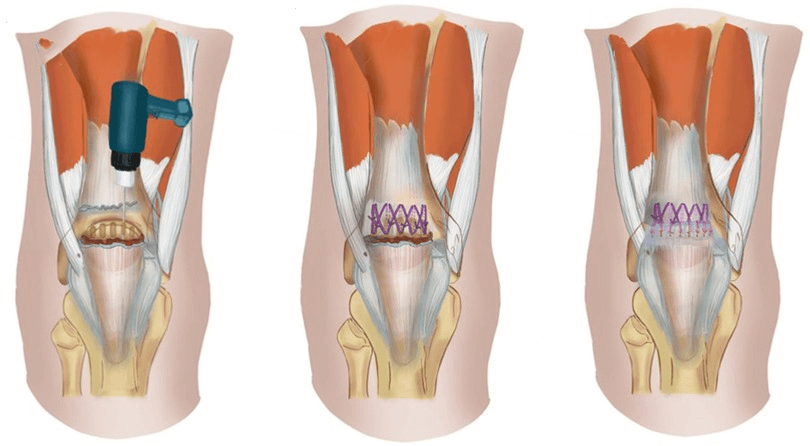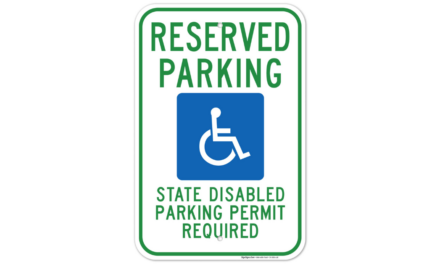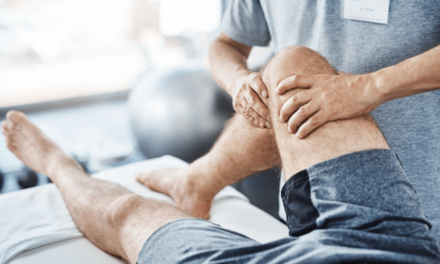Quad Tendon Tear Surgical Repair: When is it Necessary?
In most cases, surgical repair is necessary for complete quadriceps tendon ruptures to restore full functionality and strength in the knee. Partial ruptures may be treated conservatively with immobilization and physical therapy, but surgery remains the gold standard for complete tears.
Surgical repair involves reattaching the tendon to the kneecap and restoring its tension and alignment. There are various techniques used depending on the severity of the rupture, the patient’s overall health, and the surgeon’s preference.
Types of Surgical Repair
Primary Repair with Suture Fixation
Overview: This is the most common and standard surgical technique for quadriceps tendon repair. It is typically used for acute (recent) ruptures. The surgeon reattaches the torn tendon to the patella using strong, non-absorbable sutures.
Procedure: During the surgery, the torn tendon is identified, and sutures are placed through the tendon and bone of the kneecap. The sutures are securely tied to ensure the tendon is firmly attached to the patella, allowing for proper healing.
Recovery: This procedure usually requires a period of immobilization in a brace, followed by a gradual progression to weight-bearing and physical therapy. Full recovery can take between 4-6 months.
Augmented Repair with Tendon Grafting
Overview: In cases of chronic or delayed diagnosis, or where the tendon tissue is severely degenerated, an augmented repair may be necessary. This method uses a graft (usually taken from the patient’s hamstring or an allograft) to reinforce the repair.
Procedure: The surgeon uses a tendon graft to strengthen the reattachment. This graft is secured alongside the original tendon to the patella, ensuring that the repair is strong enough to handle daily activities and reduce the risk of re-rupture.
Recovery: Recovery for an augmented repair is similar to primary repair but may take longer depending on the extent of tissue damage and graft healing.
Transosseous Tunnel Repair
Overview: This technique involves drilling small holes or “tunnels” into the patella through which sutures are passed. The sutures are then tied securely, providing a strong anchor for the torn quadriceps tendon.
Procedure: The surgeon drills these tunnels in the kneecap, weaves the sutures through them, and secures the tendon to the patella by tying the sutures. This technique offers excellent stability and is commonly used in active individuals or in more complex cases.
Recovery: Like primary repair, transosseous tunnel repair requires immobilization, followed by physical therapy. Patients can expect a gradual return to activity over 4-6 months.
Suture Anchor Repair
Overview: Suture anchors are small devices implanted into the bone to hold sutures in place. This technique allows for a more minimally invasive approach, as fewer incisions are required compared to transosseous tunneling.
Procedure: The surgeon inserts suture anchors into the patella and ties the torn tendon back in place. This method is particularly useful in athletes and individuals who need a quicker recovery time, as the anchors provide a strong, stable fixation with minimal disruption to the surrounding tissues.
Recovery: Recovery is similar to other methods, but the minimally invasive nature of this technique may allow for a faster initial healing period. Physical therapy begins sooner to regain range of motion and strength.
Quadriceps Tendon Reconstruction
Overview: In rare cases where there is extensive tendon damage or a failed previous repair, quadriceps tendon reconstruction may be required. This involves rebuilding the tendon using a graft or artificial tendon material.
Procedure: The surgeon may use either autografts (from the patient’s own tissue) or allografts (from a donor) to reconstruct the tendon. Artificial materials are also sometimes used. This is a complex procedure often used as a last resort.
Recovery: Recovery from reconstruction is generally longer and more complex, requiring careful rehabilitation to ensure the tendon heals properly. Patients can expect a longer period of limited mobility and a more gradual return to physical activity.
Recovery and Rehabilitation
Regardless of the type of surgical repair, recovery from quadriceps tendon rupture repair involves several key stages:
Immobilization: The knee is usually placed in a brace or cast for several weeks to allow the tendon to heal. During this period, weight-bearing is typically limited.
Physical Therapy: Once initial healing has occurred, physical therapy focuses on restoring range of motion, strengthening the quadriceps muscles, and gradually reintroducing weight-bearing activities.
Return to Activity: Depending on the type of surgery and individual recovery, patients can typically return to light activities within 3-4 months. Full recovery, including sports or heavy physical activity, may take up to a year.
Conclusion
Quadriceps tendon ruptures are serious injuries that require careful surgical repair for optimal outcomes. The type of surgical technique used will depend on the nature of the injury, with options ranging from primary suture fixation to more complex reconstruction procedures. Patients should work closely with their orthopedic surgeon and physical therapist to ensure a successful recovery, following a carefully planned rehabilitation program tailored to their specific needs.
If you’ve suffered a quadriceps tendon rupture, consult with your orthopedic specialist to determine which repair option is right for you and how you can optimize your recovery process.








